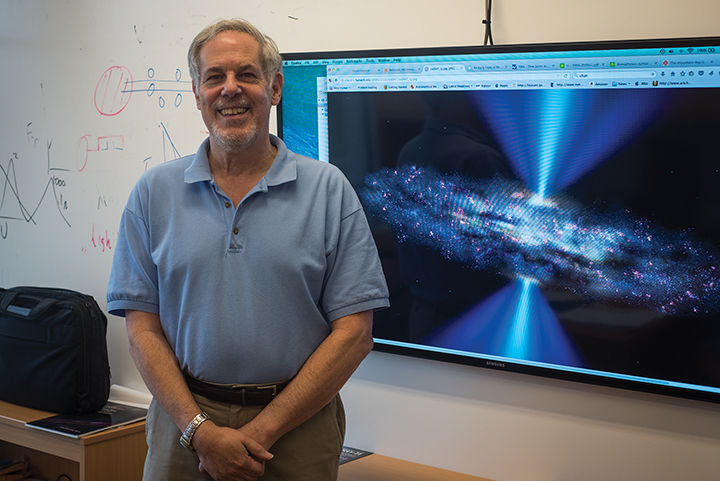
Richard Mushotzky, an astronomy professor, poses in front of an image of a black hole.
Black holes are known to exist in two size classes: some, called stellar-mass black holes, can have a mass up to a few dozen times larger than the sun’s; others, called supermassive black holes, can weigh billions of times the sun’s mass.
Recently, however, a team of researchers from the University of Maryland and NASA observed black hole activity that could indicate the existence of a midsize black hole. The Astrophysical Journal Letters published the team’s findings in August.
“We found several bright sources in nearby galaxies. … We believed they were black holes,” said Richard Mushotzky, an astronomy professor at this university and an author of the study. “The sources seemed to be more than a few hundred times the mass of the sun. … Their nature was an enigma.”
Stellar-mass black holes form when huge stars collapse. Surrounding stars then dump material into those black holes, which causes them to shine, said Brad Cenko, a research astrophysicist at NASA’s Goddard Space Flight Center and astronomy professor at this university.
READ MORE: UMD researchers discover evidence of binary supermassive black holes
Supermassive black holes seem to occur in the center of every reasonably sized galaxy, he said, like the one at the center of the Milky Way, which measures more than 4 million times the mass of the sun.
“For a long time, it hasn’t been clear if there are intermediate-sized black holes, or black holes that are about 1,000 to 10,000 times the mass of the sun,” Cenko said. “Until very recently, there hasn’t been robust evidence for these systems.”
Researchers used data from the European Space Agency’s XMM-Newton satellite, Mushotzky said, to observe ultraluminous X-ray sources, which are extra bright, seen in nearby galaxies.
Researchers identified a few sources that emitted enough radiation to either be stellar-mass black holes almost “masquerading” as a larger black hole or evidence of a midsize black hole, Cenko said.
At least one source, NGC 1313 X-1, was discovered several decades ago, Cenko said, and given its large luminosity, was immediately identified as a candidate for an intermediate-mass black hole. Additional studies, including this one, built on this evidence to support the suspected existence of midsize black holes.
“The black holes that are roughly the mass as our sun emit radiation with characteristic frequency, which tells you something about the mass of the black holes,” Cenko said. “By finding out the frequency at which this ultra-luminous X-ray source was emitting radiation, we were able to sort of weigh the black hole, using lower-mass ones as an anchor.”
The potential midsize black holes the team studies are also sources of unique gravitational waves, which could provide further topics for study, said Cole Miller, an astronomy professor who was not involved with this research.
READ MORE: University of Maryland researchers discover new black hole findings
“Because the normal methods of making black holes do not apply for these [intermediate-mass] sources, there is a lot we could learn from them,” Miller said.
Mushotzky said further study of midsize black hole sources could inform further investigation and provide a better understanding of stars and black holes in galaxies.
Cenko said the method of mass measurement the team used for this research could help to identify more intermediate black hole candidates moving forward.
“There are a number of other sources that are bright enough that we think we could do this, but we have to analyze the data carefully,” Cenko said. “We are excited to use this technique to try to find some more.”



